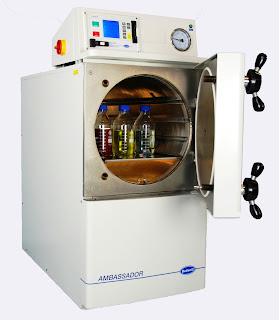Methods
of Sterilization:
Definition: Sterility is the absence of viable microorganisms. It is essential
that the effect of the chosen sterilization procedure on the product (including
its final container or package) is investigated to ensure effectiveness and therefore the integrity of the product, which the procedure is valid before being applied in follow. guaranteeing that the selection of the instrumentality is like to permit the optimum sterilization to be applied.
Steam Sterilization:
Applicable Products: Large Volume Parenteral Liquids.
Definition:
Sterilization is finished by saturated steam struggling particularly
for binary compound preparation. The reference conditions for binary
compound preparations ar heating at a minimum of 1210C for quarter-hour.
different mixtures of your time & temperature could also be
used providing it's been satisfactorily incontestible that the method
chosen delivers AN adequate and duplicable level of unwholesomeness once
operational habitually among the established tolerances. The procedures
and precautions utilized ar like to administer a SAL (Sterility
Assurance Level) of 10-6 or higher. Spores of B stearothermophilus ar
suggested for validation. there's no growth of the reference
microorganisms once the biological indicators are exposed to steam at
121±10C for fifteen min.
Time at Temp. Cycles for
Moist Heat Sterilization are given in Table-1
Table-1
Temperature (0C)
|
Pressure (p.s.i.)
|
Minimum Holding Time (min)
|
||
(kPa)abs
|
(lbf/in2)g
|
(bar)
|
||
115-116
|
172
|
10
|
1.7
|
30
|
121-123
|
202
|
15
|
2.0
|
15
|
126-129
|
242
|
20
|
2.4
|
10
|
134-138
|
304
|
32
|
3.0
|
3
|
106
|
1.6
|
85
|
||
Ref: BP 2004, Vol.-4, and
Pharmaceutical Practice
Ethylene
Oxide Gas Sterilization:
Applicable Products: Infusion Sets, Syringes and Scalp Vein Sets.
Definition: Ethylene Oxide is
extremely
effective at killing microorganisms and its activity is related to its
action
as an alkylating agent. Reactive hydrogen atoms on hydroxyl, carboxyl,
sulphydril & amino groups can all be replaced with hydroxyethyl
groups thus
interfering with a wide range of metabolic activities. It is essential
that
penetration by gas and moisture into the material to be sterilized is
ensured
and followed to elimination of the gas. where attainable, the gas
concentration, ratio, temperature and period of the method area unit
measured and recorded.. Measurements are made where sterilization
conditions are
least likely achieved, as determined at validation. Spores of Bacillus subtilis var. niger are recommended for
validation.
Concentration of Ethylene Oxide & Time of Exposure: Manufacturer of ethylene
oxide sterilizer recommends, for most purposes, exposure to 850-900 mg/l for 3
h or 450 mg/l for 5 h, at 540C. A powerful vacuum immediately is to
be applied after sterilization, e.g. 1.5 kPa (15 mbar) for 2 hours. Also
partial vacuums are applied to about 20 kPa (0.2 bar) and then admit sterile
air to atmospheric pressure as a flushing agent. This is repeated for 5 to 6
times.
Different Factors
responsible for EO Gas sterilization are given in Table-2.
Table-2
EO Gas Sterilizer
|
Temp.
|
Pressure (mbar)/
Gas Conc.
|
Relative Humidity
|
Time (HoldingTime)
|
Standard
|
540C
|
450 mg/L
|
50%
|
5 hours
|
Standard
|
540C
|
850-900mg/L
|
50%
|
3 hours
|
For Biological Indicator
|
540C
|
600 mg/L
|
60%
|
60 min.
|
At Infusion Set
|
450C
|
800/150 mbar
|
60%
|
240 min
|
At Syringe
|
310C
|
900/525 mbar
|
60%
|
60 min
|
Ref: BP 2004, Vol.-4, & Pharmaceutical Practice,
Dry Heat Sterilization:
Applicable Particulars: Glass Apparatus.
Definition: Sterilization by dry heat is usually carried out in a hot air oven in
which heat is transferred from its source to the load by radiation, convection
and to a small extent by conduction. Spores of Bacillus subtilis var. niger are recommended for
validation
Time Temperature
Combinations:
· minimum one hundred eighty degree Celsius for not less than 30
minutes
· minimum one hundred seventy degree Celsius for not less than 1
hour
· minimum one hundred sixty degree Celsius for not less than 2
hours
For
Depyrogenation of the Glassware, Treatment is done at 2500C for 30
minutes or 2000C for 1 hour.


No comments:
Post a Comment